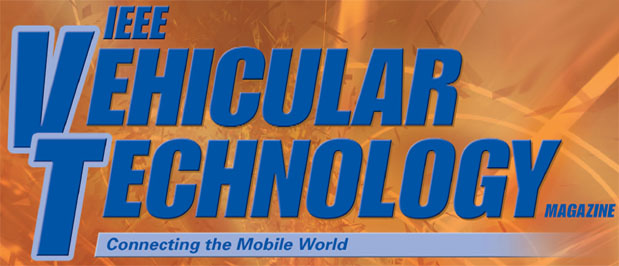Call For Papers:
IEEE VT Magazine Special Issue on Advanced Aerial Mobility
Important Dates |
|
|---|---|
| Manuscript Submission EXTENDED: | 1 December 2020 |
| First Round Reviews by: | 12 February 2021 |
| Second Round Submissions by: | 29 March 2021 |
| Second and Final Round Reviews: | 15 May 2021 |
| Authors submit final articles: | 25 May 2021 |
| Publication: September 2021 | |
Recent advances in unmanned aviation opened new opportunities for the aviation industry. Encouraged by the successful demonstrations of projects such as the U-Space and Unmanned Aircraft System (UAS) Traffic Management (UTM), the aviation industry around the world is moving towards more advanced applications of air mobility including services such as air taxi and air ambulance. At the same time, the academic research community is finding new challenges to address in high-density, low altitude flying UASs.
Advanced aerial mobility refers to “transformative and disruptive new airborne technology supporting an ecosystem designed to transport people and things to locations not traditionally served by current modes of air transportation, including both rural and the more challenging and complex urban environments”, according to the National Academies Press. The platforms that are being developed for advanced aerial mobility applications are typically short-range, runway independent, and highly automated vehicles such as the electric powered Vertical Takeoff and Landing (eVToL) aircraft. Along with new platforms, there are new developments emerging in other areas including vertiport design, software, sensors, alternative energy generation and storage solutions. Community testbeds and service frameworks (e.g., Aerial Experimentation Research Platform for Advanced Wireless and U-Space framework for safe and secure access to airspace) are being developed for experimentation of advanced aerial mobility applications around the world.
New challenges are predicted in areas including airspace operations, traffic management, vehicle health integrity monitoring, and human-autonomy teaming, to name a few. In parallel, there is a need for identifying efficient strategies for micro-weather modeling and prediction, collision avoidance in close encounters, detection of uncooperative and rogue aircraft, and geofencing and GPS-denied operation strategies among others. Advances are also required in communication, navigation, and surveillance domains. Airborne communication options ranging from LTE and 5G networks to satellite links, as well as direct and over-the-air radio frequency links using either licensed or unlicensed frequency spectrum need to be investigated.
This special issue aims to share the progress and efforts being made by researchers, practitioners, and regulators towards advanced aerial mobility. This call solicits novel concepts that are currently being pursued or transformative ideas envisioned for this emerging area of research. Original submissions that discuss research, development, experimentation, and evaluation strategies that support advanced aerial mobility are encouraged within the following scope or related areas:
- Autonomous air space operations: Flight planning, scheduling, and tracking
- Airborne communications: 5G and beyond-5G cellular, satellite, and radio frequency and other (e.g., optical) communication support for UAS, for both air-ground (AG) and air-air (AA)
- Aerial platforms: Aerodynamics, power, propulsion, energy efficiency
- Command, control, navigation, and surveillance: Aircraft identification, beyond visual line of sight and beyond radio line of sight communication, and navigation in GPS denied areas
- Remote Identification (ID) support for UAS using low-power wide-area network technologies: Theoretical/simulation results, analysis, and experiments with technologies such as LoRa, Sigfox, WiFi, Bluetooth 4.X and 5.X, NB-IoT, and ASTM standards for remote ID
- Multi-vehicle cooperation: Collision avoidance and conflict management and resolution
- Traffic Management: Geofencing, air corridors, and trajectory design and optimization
- Human-autonomy and teaming: Best practices and strategies for pilots to interact with unmanned systems in the same air space
- Noise mitigation: Acoustic modeling, measurement, and control strategies
- Weather Prediction and Modeling: Prediction and modelling of micro-weather at low altitudes
- Computing paradigms: Edge computing, fog computing and cloud computing support for UAS, including machine-learning (ML) and artificial intelligence (AI) based approaches
- Experimental Platforms: Experimental results and proof-of-concept prototypes related to advanced aerial mobility
- Security: Communications, navigation, and surveillance security, including techniques to ensure both physical layer security and higher-level security
Submitted papers should contain state-of-the-art research or technical material presented in a tutorial or survey style. All manuscripts must adhere to the IEEE VTM guidelines. Authors should submit a PDF version of their manuscript to ScholarOne Manuscripts™ (select Special Issue)
Guest Editors
Kamesh Namuduri (University of North Texas, USA)
Uwe-Carsten Fiebig (Institute of Communications and Navigation of DLR, Germany)
David W. Matolak (University of South Carolina, USA)
Helka-Liina Määttänen (Ericsson, Finland)
Ismail Guvenc (North Carolina State University, USA)
K.V.S Hari (Indian Institute of Science, India)

